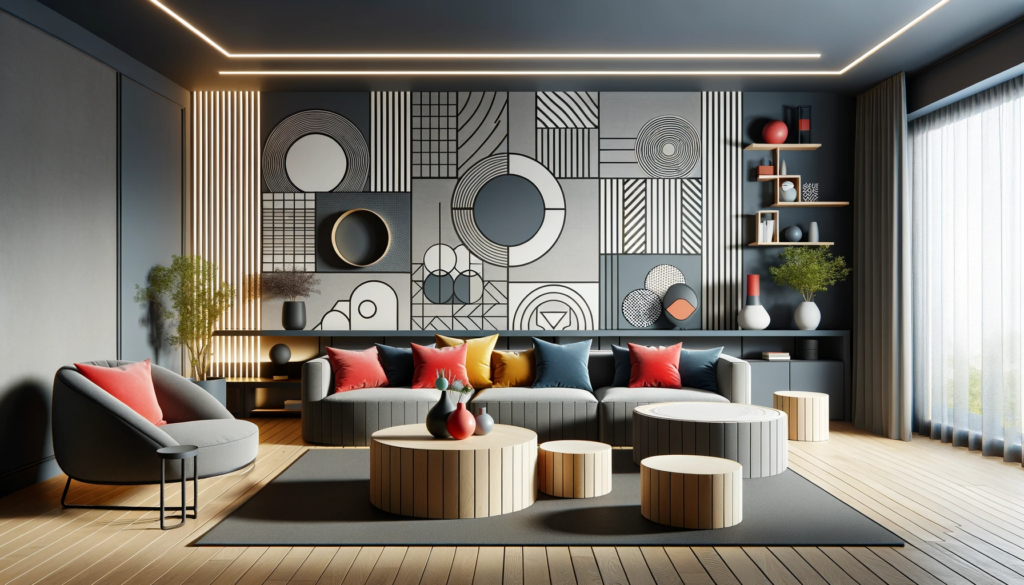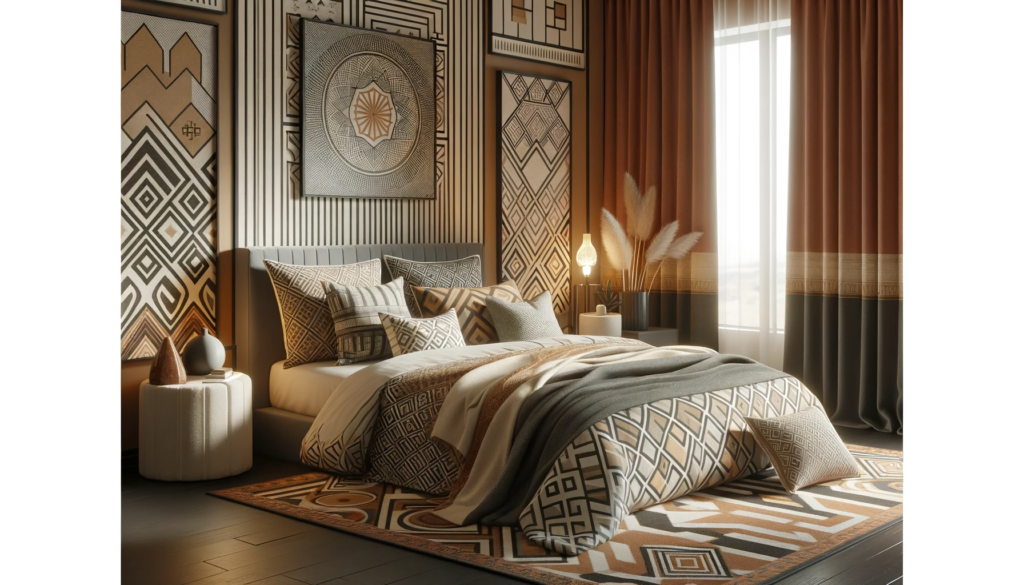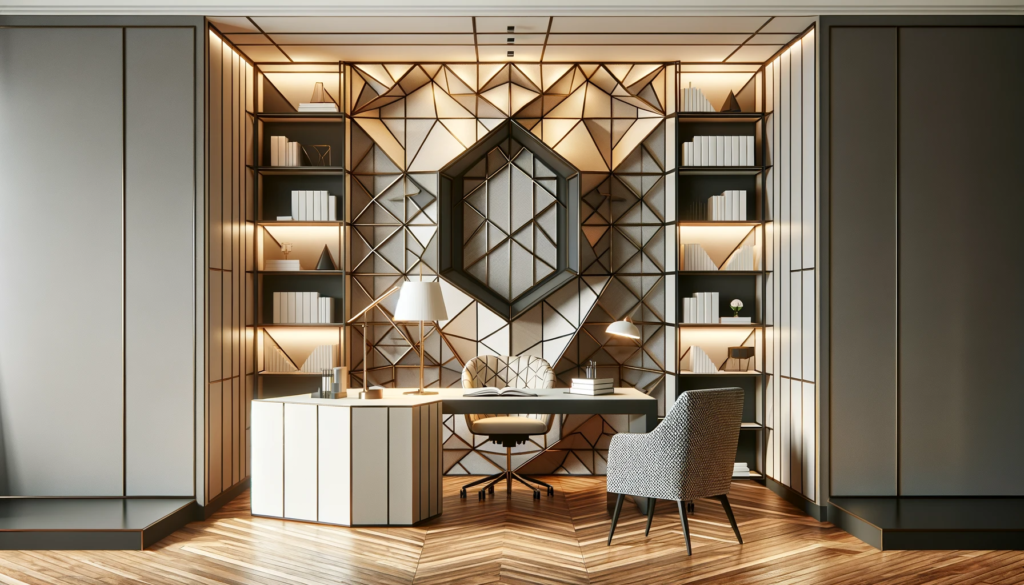Interior design’s realm is a creative playground, where a blend of different elements converge to forge spaces that are not only harmonious and functional but also visually appealing. Key among these elements are geometric shapes and patterns, which stand out for their remarkable mix of symmetry, balance, and visual allure. This introduction ventures into the core of geometric design within interior spaces, tracing its historical origins and highlighting its substantial role in contemporary interior design.
In the context of interior spaces, geometric design involves leveraging shapes such as circles, squares, triangles, and polygons, along with intricate patterns formed from these shapes, to boost both the aesthetic charm and practicality of a room. These shapes and patterns manifest in various ways, from the fundamental structure of a space to detailed designs on wallpapers, fabrics, and decorative items. Geometry’s role in interior design is significant, influencing not just the visual aspects but also the atmosphere and emotional tone of a space.

History and Evolution of Geometric Design in Interiors
Delving into the annals of history, it’s evident that geometric patterns have been integral to human societies for millennia. Civilizations like the Greeks and Egyptians extensively used geometric motifs in their architecture and artworks, emblematic of order, balance, and mathematical accuracy. Fast forward to the 20th century, the Art Deco era of the 1920s and 1930s propelled geometric design to the vanguard of interior design, characterized by pronounced lines and forms, epitomizing elegance and flair. Presently, geometric design has undergone a transformation, effortlessly merging with diverse interior styles, ranging from minimalist to eclectic, thus opening avenues for immense customization and creative expression.
The incorporation of geometric shapes and patterns in interior design transcends mere aesthetic allure; it is intrinsically linked to psychological principles. Different geometric patterns trigger varied emotional responses and perceptions – for example, circles often symbolize gentleness and flow, squares and rectangles denote sturdiness and dependability, whereas triangles add an element of vigor and motion. This psychological dimension empowers designers to craft spaces that significantly impact the emotions and behavior of those inhabiting them, establishing geometric design as a potent instrument in interior decoration.
As we delve deeper into the realm of geometric shapes and patterns in interior design, we’ll discover an extensive range of applications. These range from prominent features in wall finishes and floorings to more nuanced additions in furnishings and decor. This exploration is not merely about keeping pace with trends; it’s about grasping how the enduring language of geometry can metamorphose spaces into mirrors of personal identity, cultural values, and artistic insights.
The Psychology of Geometric Design
In the complex mosaic of interior design, geometric shapes and patterns play a role that transcends mere visual appeal; they are profound channels of psychological influence. The essence of geometric design in interior spaces lies in its capacity to stir specific emotional reactions and shape perceptions. For example, circular forms often instill a sense of togetherness and safety, fostering an environment that’s both inviting and harmonious. Conversely, angular forms such as triangles and squares are emblematic of fortitude and steadiness, and they can also inject a sense of vitality and motion, depending on their placement and context.
Furthermore, the way these shapes are repeated and arranged in designs can dramatically alter the ambiance of a space. Geometric patterns that are symmetrical and uniform often create feelings of structure and predictability, promoting an atmosphere of tranquility and orderliness. On the flip side, patterns that are asymmetrical or irregular tend to activate the mind, resulting in an environment that’s more vibrant and captivating. This psychological aspect is vital in the process of designing, as it enables creators to fashion spaces that not only meet functional and aesthetic needs but also connect with the emotional and psychological state of those using the space.
Thus, the application of geometric design extends well beyond simple ornamentation; it delves into the realm of human psychology, where shapes and patterns act as instruments to modify mood, behavior, and even thought processes. Whether it’s in a home or a business environment, the deliberate use of geometric shapes and patterns can cultivate spaces that boost comfort, efficiency, and overall well-being. As we explore further into the domain of geometric design, it becomes evident that these patterns are more than just decorative elements; they are intimately linked with the human experience, influencing our perception and interaction with the spaces around us.

Types of Geometric Shapes and Patterns
The sphere of interior design is abundant with an array of geometric shapes and patterns, each contributing its distinctive flair and style to a space. These elements can generally be divided into three categories: basic geometric shapes, intricate patterns, and the application of symmetry and asymmetry. The basic geometric shapes encompass essential forms such as circles, squares, triangles, and rectangles. These fundamental shapes serve as the foundation for more elaborate designs and are chosen often for their inherent simplicity and equilibrium.
In contrast, intricate patterns arise from the blending and repetition of these basic shapes, resulting in complex and frequently captivating designs. This category includes tessellations, where a single shape is replicated seamlessly; fractals, characterized by a recurring pattern at various scales; and various polygons, ranging from straightforward pentagons to more complex shapes with numerous sides. Each pattern type offers a distinct visual appeal and can considerably alter the atmosphere of a room.
Moreover, the incorporation of symmetry and asymmetry in geometric design contributes an additional dimension of visual intrigue. Symmetrical patterns, mirroring each half of a design, project a sense of balance and unity. Conversely, asymmetrical patterns, which eschew such mirroring, infuse spaces with energy and visual interest, often rendering them more contemporary and dynamic.
A deeper exploration into these types of geometric shapes and patterns uncovers the breadth and adaptability of geometric design in interior spaces. These elements empower designers to craft environments that span from calm and structured to vibrant and vigorous, showcasing the immense creative potential of geometry in the realm of interior design.
In subsequent sections, we will further investigate each category, examining the traits, applications, and impacts of basic geometric shapes, intricate patterns, and the synergy of symmetry and asymmetry in the field of interior design.
Circles
The circle, an enduring and ubiquitous emblem, imparts a sense of gentleness and fluidity to interior environments. In the realm of design, circles typically symbolize togetherness and safeguarding, fostering an aura of wholeness. The incorporation of circular features in a space, like round tables, arched couches, or orb-shaped lighting, can alleviate the rigid lines of a room, rendering it more inviting and balanced. Particularly adept at creating a center of attention, the use of circles encourages a natural flow of vision throughout the room.
Squares
Squares, characterized by their equilateral sides and precise right angles, exude a feeling of steadiness and organization. Within the sphere of interior design, square forms are commonly linked with equilibrium and a formal aesthetic. They are popular choices in various design elements, such as floor and wall tiling, modular furnishing, and grid-patterned shelving. The presence of squares in a design instills a sense of dependability and framework, making them perfectly suited for spaces that benefit from an air of solidity, such as in office settings or minimalist-styled living spaces.
Triangles
Triangles, with their energetic shape, suggest motion and directionality. Their sharp angles can infuse a space with a feeling of vigor and liveliness. In the field of interior design, triangles find their place in various forms, such as in the patterns of fabrics, wall decorations, or even within the architectural details of a room. They have a unique ability to direct the viewer’s gaze, fostering a sense of dynamism that results in more vibrant and interactive spaces. Especially in contemporary and cutting-edge design styles, triangular patterns stand out for their effectiveness in adding an element of modernity.

Incorporating Geometric Elements in Interior Spaces
The fusion of geometric elements in interior spaces stands as a tribute to the enduring charm of shapes and patterns in design. Aiming for either subtlety or boldness, the application of geometric principles can elevate an ordinary space into one that is visually compelling and well-integrated. This article delves into the myriad ways geometric elements can be woven into interior design, thereby enhancing both its aesthetic appeal and practicality.
Wall Treatments: Wallpapers, Murals, and Paint Techniques
A significant method to embrace geometric design is through wall treatments. Geometric wallpapers can invigorate a room, featuring either striking, bold patterns or delicate, detailed motifs. Murals adorned with geometric patterns present an artistic, personalized flair, creating walls that capture attention and intrigue. Subtler approaches, like color blocking or geometric stenciling in paintwork, can infuse depth and fascination into a space without being overbearing. These approaches help demarcate areas within a room, establish focal points, or simply introduce an element of visual intrigue.
Flooring: Tile Patterns, Carpets, and Area Rugs
Floors serve as another platform for geometric expression. Tile arrangements, particularly popular in bathrooms and kitchens, vary from simple checkerboard layouts to intricate mosaic styles, offering both durability and a timeless aesthetic. Carpets and area rugs featuring geometric patterns not only ground a room’s décor but also add comfort and fashion. Opting for the right design can also alter spatial perception; for example, extended diamond shapes can give the illusion of a more spacious room.
Furniture and Fixtures: Shape-Driven Design Choices
Furniture and fixtures offer additional avenues to integrate geometric elements. Furniture pieces with pronounced geometric forms can act as focal points, while upholstery with geometric patterns can layer in texture and hue. Regarding fixtures, lighting solutions like pendant lights or lamps in geometric shapes fulfill functional roles while doubling as art pieces, contributing to the space’s overall design story.
Accessorizing with Geometric Elements
Smaller decorative items and accessories also play a crucial role in embedding geometric designs within a space. Items such as cushions, throws, and drapes adorned with geometric patterns can unify a room’s aesthetics, while art pieces and sculptures with geometric themes add a touch of elegance and modernity. Everyday objects like mirrors or storage containers, chosen for their geometric forms, can enhance the space’s cohesive visual appeal.
Balancing Geometry with Other Design Elements
While geometric design is visually striking, maintaining balance is essential. It’s important to consider the scale of the patterns and shapes employed to ensure they augment rather than overpower the space. Combining geometric elements with organic shapes can achieve a balanced harmony, avoiding a too structured or sterile feel. The color scheme also plays a pivotal role; bolder patterns can be set against a neutral backdrop to let the geometry shine, whereas softer designs may benefit from more vivid colors.

Conclusion
The delve into geometric shapes and patterns in interior design uncovers a captivating blend of artistry, scientific principles, and psychological insights. Ranging from basic geometric forms that trigger diverse emotional reactions to intricate patterns that infuse depth and fascination, geometry stands as a potent instrument in the realm of interior design. It is instrumental in crafting spaces that are visually attractive and resonate emotionally.
Geometric elements find their expression in various aspects of interior design, such as wall treatments, flooring, furniture, and decorative accessories. These elements provide a wide spectrum for both designers and homeowners to showcase their individual tastes and characters. Be it the harmonious symmetry of circles, the groundedness of squares, the energy of triangles, or the enthralling complexity of tessellations and fractals, each geometric shape contributes a distinctive essence to the overall design. Employing these shapes and patterns enables the creation of environments that vary from tranquil and comforting to lively and spirited.
The psychological influence exerted by geometric design in interior settings is significant. These shapes and patterns have a profound effect on our perceptions and emotions, shaping spaces that bolster comfort, efficiency, and general well-being. The thoughtful application of geometric principles in design results in environments that align with the emotional and psychological needs of their inhabitants, thus elevating interior design to a more comprehensive and people-focused field.
The incorporation of geometric shapes and patterns in interior design stands as a testament to the timeless charm and adaptability of geometry. It opens up limitless opportunities for customization and inventive expression, transforming spaces in a plethora of ways. As we continue to investigate and play with these essential design elements, we pave new paths for creativity and innovation in interior design, culminating in spaces that are not just visually impressive but also deeply intertwined with the human element.